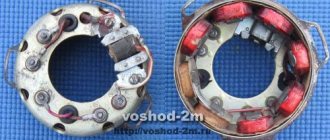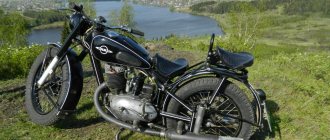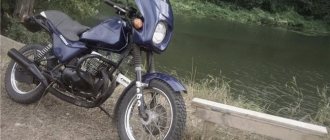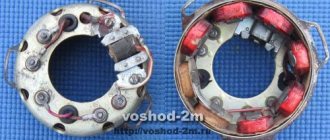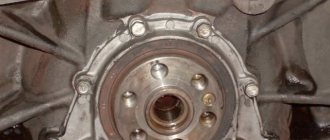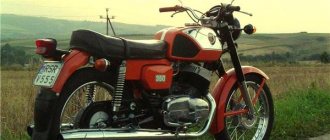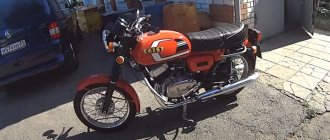Generator Voskhod G-427
Generator G-427 alternating current with excitation from a permanent magnet with an inductive sensor of the electronic ignition system. In the grooves of the stator, made of stamped electrical steel plates, eight coils are placed, which form four independent circuits: - power supply to the ignition storage capacitor; — lighting and sound signal; — direction indicators; — braking signal.
Voltage regulation in the circuits of lighting loads is carried out according to the principle of parametric regulation, i.e. The winding data of the generator are selected in such a way that as the rotor speed increases, the voltage at the generator terminals changes within certain limits for a certain load. Attaching the generator stator to the engine crankcase provides adjustment of the ignition timing.
On the generator stator cover there are terminals: - charging coils of the power supply circuit of the Voskhod ignition storage capacitor; — direction indicators; — brake signal; — lighting; — sensor.
Which are marked accordingly: >, >, >, > and >.
The sensor is mounted on the generator stator cover using screws.
Generator rotor
The generator rotor with the sensor rotor located on it is mounted on the right axle axis of the engine crankshaft with a bolt and is secured against rotation by a key.
Five random articles about motorcycles:
Java 634-01. Detailed description of the new product
Meet the new Java This year, the Java 350 model 634-01 is replacing the popular YAVA-250 and YAVA-350 motorcycles of the “559-07” and “360-00” models in the USSR.
Motorcycle enthusiasts already know about this new motorcycle from articles published in the magazines “Behind the Wheel” (1973, No. 12) and “Czechoslovak Motor Review”. How does this motorcycle differ from its predecessors) We asked a representative of the foreign trade association “Motokov” to talk about this » Yana BUZEKA. The new machine was developed taking into account the vast experience gained from operating JAVA motorcycles, of which almost a million have been delivered to the USSR to date. It should be noted that these motorcycles were intended mainly for work on fairly high-quality roads. Nevertheless, as you know, thanks primarily to the exceptional reliability of the engines, JAVA motorcycles have reached areas of your vast country for which they were essentially not designed: this is... Read more >>
To prevent the fork from knocking
How to eliminate play in the front fork rod in the upper bridge On some YAVA motorcycles, after 30 - 50 thousand kilometers, wear leads to play in the front fork rod in the upper bridge.
It reveals itself with unpleasant knocking noises when driving on bad roads. Using foil to reduce the gap is ineffective, and tightening the nut does nothing. It was possible to eliminate the backlash using a special nut and a conical ring (Fig. 1). They are made of tool steel (you can, for example, use 40X) with hardening to a hardness of 45 - 50 HRC. We install new parts instead of the round nut, as shown in Fig. 2. When the upper nut is tightened, the split ring opens and tightly fixes the fork rod in the upper bridge. In this case, you do not need to install the lock washer. Rice. 1. Nut (left) and ring. Rice. 2. Mounting unit for the upper bridge: 1 — steering column of the frame; 2 - cone nut: 3 - bridge: 4 - split ring; 5 - nut;... Read more >>
How to achieve smooth brake action on a Java motorcycle
“I can’t seem to get smooth brake action on my Java motorcycle.
Braking occurs jerkily, although the pads and cables are in good condition. What could be the reason?" - asks K. Lobachev named after the city of Kolomna. Jerks when braking motorcycles and cars are typical for those cases when the brake drums have an irregular (oval, faceted, etc.) shape of the working surface. The pads are pressed against it unevenly - stronger in areas located closer to the drum axis, weaker - in areas farther from it. In motorcycle (spoke) wheels, the shape of the drum is usually disrupted by strong impacts on various obstacles or due to uneven tension of the spokes (most often after reassembling the wheel ).To eliminate drum deformation, first adjust the tension of the spokes, and if this is not enough, grind the working surface of the drum on a lathe. The best results are obtained by processing the drum in the assembled wheel. If the machine does not call... Read more >>
Motorcycle IZh Planet Sport. The most frequently asked questions and their answers
In questions and answers Recently, the editors have increasingly received letters from readers with questions about the IZH-Planet-Sport motorcycle.
We selected the most typical ones and contacted the manufacturer. The answers of designers and specialists are in front of you. What changes has the motorcycle undergone during the production process from the beginning of production to the present? There are quite a lot of changes. Let's name the main ones. The engine has a new cylinder head. Now its fins are not “fan-shaped”, but regular, and instead of a “jockey cap” type combustion chamber, there is a chamber formed by concentric spheres. The number of screws holding the crankcase halves and the cover together has been increased, and the engine mount to the motorcycle frame has been strengthened. The shape of the muffler has been improved, which prevents it from coming into contact with the road when the car tilts, and the diameter of the exhaust pipe has also been increased. The imported Mikuni carburetor was replaced by the domestic K62M, which has a f... Read more >>
Caring for a sunrise motorcycle generator - how to remove, what to check and install correctly
Generator maintenance mainly comes down to tightening the threaded fasteners of the generator stator and rotor, as well as the wire terminals.
In order to remove the generator, you must:
- disconnect the wires of the ignition circuit, sensor, brake light and direction indicators from the generator terminals;
- unscrew the three screws securing the stator to the crankcase and remove the stator;
- Unscrew the bolt securing the generator rotor and, with light, careful blows of a wooden hammer on opposite sides of the rotor, remove it from the trunnion and remove the key.
Checking the removed parts
After removing the generator stator and rotor, wash the parts with clean gasoline and carefully inspect them. Disassemble the wire fastening terminals on the stator. Wipe dry all insulating parts of the terminals.
Generator installation
Installation is carried out in the reverse order, in this case it is necessary:
- check the runout of the generator rotor, which should be no more than 0.1 mm with the bolt secured;
- tighten the generator stator without distortions, ensuring a tight fit to all three supports;
- install the ignition correctly;
- The generator wires must be securely fastened and well insulated from each other.
What does the MotoLife-Market.ru store offer?
If you are the owner of a Voskhod, Minsk or Sova bike, and over time the original parts require replacement, you have come to the right address. Please note the wide range of components for these motorcycles in our catalog. With the help of properly selected spare parts, you can not only fix the breakdown of your vehicle, but also make its performance more efficient. To do this you will need very little time and a minimum of technical knowledge. If you want to modernize or tune your bike, we also have something to offer you, depending on your imagination and the allocated funds.
Ignition adjustment Voskhod
The ignition timing is set by turning the generator stator after first loosening the three screws securing the stator to the crankcase. For normal engine operation, it is necessary that the moment of spark formation (on the generator, this moment is determined by the coincidence of the sensor rotor groove with the protrusion on the sensor coil frame. Fig.) coincides with the moment when the piston does not reach the top dead center of 2.5-3.0 mm (at running the engine on gasoline with an octane rating of 92).
The gap between the rotor and the core of the sensor coil should be within 0.3±0.05mm.
The gap should be set as follows:
- loosen the screws securing the sensor stator to the generator stator cover;
- By moving the sensor stator in the grooves of the generator stator cover, set the required gap, and then tighten the fastening screws.
For more accurate ignition installation, it is recommended to determine the piston position with the cylinder head removed.
Specifications
- Dimensions: 2000x1200x850 mm - length, height and width, respectively. Weight - 122 kg. Engine power - 15 hp. Gasoline consumption is 4.2 liters per 100 km in mixed mode, tank volume is 14 liters. Gearbox – 4-speed with mechanical gear shifting. Ground clearance - 125 mm. Maximum speed is 105 km/h.
| Basic data | |
| Length Width Height | 2000/ 850/ 1200 |
| Base, mm, no more | 1300 |
| Ground clearance, mm, no more | 125 |
| Weight of the equipped motorcycle, kg, no more | 135 |
| Load capacity, kg no more | 160 |
| Dynamics and efficiency | |
| Maximum speed, km/h, not less | 105 |
| Fuel consumption | 4.2l/100 km |
| Fuel tank capacity | 14 |
| Engine | |
| Type, timing | carburetor, two-stroke |
| Number of cylinders | 1 |
| Working volume, cm3no more | 173.7 |
| Bore/stroke | 62/57.6mm |
| Maximum power, kW (hp), not less | 14 (15) |
| Carburetor | K65 V |
| Transmission | |
| Clutch | multi-disc in oil bath |
| Clutch control | manual |
| Gear shift | foot |
| Motor transmission | single row bushing chain |
| Reverse gear | single row roller chain |
| Gear ratios | |
| Motor transmission | 2.07 |
| Transmission | 1- 3.04; 2- 1.99; 3- 1.34; 4- 1.00; |
| Rear wheel transmission | 31809 |
| Chassis | |
| Frame | tubular, closed, single |
| Suspension travel along the wheel axes, front/rear, mm, not less | 160/80 |
| Brakes | drum with mechanical drive |
| Wheels | spoked |
| Tire size | front 3.25-16 or 3.50-16, rear 3.25-16 or 3.50-16 |
Electrical diagram
Electrical circuit of the Voskhod 3M motorcycle.
Switch Voskhod - electronic KET-1
The electronic switch KET-1 is designed to work in the ignition system complete with the G-427 generator and the B-300B high-voltage transformer. Allows you to obtain a secondary voltage of up to 18 kV, at a generator rotor speed of 250 to 7500 rpm. The switch is installed in the right toolbox. The base of the commutator is connected to the ground of the motorcycle. If the switch fails, it can be disassembled and repaired
The electronic switch has three output terminals with letter markings on the body >, > and >. The ground terminal is the base of the switch.
Maintaining the switch during operation comes down mainly to tightening the threaded connections, while avoiding stripping the threads. It is necessary to protect the switch from moisture getting inside it and onto the terminals from sudden shocks and exposure to high temperatures. You should also systematically check the reliability of the electrical connection of the switch base with >, because If this condition is violated, sparking on the spark plug stops.
Voskhod 3M: nostalgia for the past
RU-MOTO rating
Verdict
The Voskhod 3m motorcycle can be the first two-wheeled vehicle for a novice biker, because... this unit can be purchased at a very low cost, and if it breaks down, it can be easily repaired even at home. This model is also valuable for collectors.
The Voskhod motorcycle rightfully earned the title of “national” in Soviet times. Its history begins with the release of the K-175 series in 1958 at the Degtyarev plant. All models were equipped with a 175.7 cc single-cylinder power unit. The 3m modification itself was produced from 1983 to 1993.
Spark plug Voskhod - spark ignition type A-23
During operation, the spark plug must be periodically cleaned of carbon deposits and the gap between the electrodes must be adjusted, which should be within 0.6-0.7 mm, which is ensured by bending the outer electrode. To seal, a copper-asbestos gasket is placed between the spark plug and the cylinder head. To eliminate radio interference created by the ignition system, a shielded tip of type A-4 is placed on the spark plug.
Tuning
On the Voskhod base you can try yourself as a customizer and build a motorcycle based on it. This is what garage craftsmen sometimes do.
If we are talking about modifying the engine, then as a rule they resort to boring the cylinder, which will slightly increase the volume. It is possible to replace the original piston with a Jupiter piston. Everything else is classic tuning of a two-stroke engine: installation of resonators, reed valves, modification of purge channels.
Conversion of Voskhod into a chopper
An example of tuning a Voskhod 3M motorcycle
Spare parts for Voskhod 3m are quite cheap and easily available. For reference, for example, the cost of a new pair of front shock absorbers costs 1,500 rubles, and a clutch kit costs only 220 rubles. On the used motorcycle market it is easy to find any spare parts at a price several times lower than new ones.
Ignition switch Voskhod - central switch
Switch 124005490201 is used as a central software switch that provides the necessary switching of lighting equipment on a motorcycle. The switch has three operating positions >, >, > in accordance with the following operating modes:
- in position > - the generator sensor circuit is shorted to ground, which ensures the engine stops.
- in the > position (driving during the day) - the ignition circuit is turned on, the direction indicator circuit operates (when the direction indicator switch is on) and the brake signal circuit (when the brake pedal is pressed);
- in position > (driving at night), two circuits are switched on:
- a) a circuit of speedometer backlight lamps, license plate lighting and city driving (through a throttle, which serves as a device that complements the parametric control of the generator);
- b) headlight lamp circuit A6-32+32 (via the light switch on the steering wheel).
Caring for the central switch comes down to periodically checking the reliability of the switch in the headlight and cleaning the moving and fixed contacts from dust and dirt by washing them in gasoline.
Engine and possible breakdowns
The Voskhod 3m engine is two-stroke, carburetor, single-cylinder. The working volume of the cylinder is no more than 173.7 cm3. Piston diameter/stroke – 62/57.6 mm. Engine power is 15 hp. A used engine in working condition can be purchased for 2000-4000 rubles.
The sore point of all Voskhod 3m is the rapid burnout of the bobbins, which have to be changed with constant use of the motorcycle, about 4 times a year. The chain tensioner also requires constant replacement - with aggressive driving it quickly breaks down. As for the engine, all the troubles that can arise with it are associated with the piston. Installing new rings or completely replacing the piston solves most problems.
Switch P-200
Light switch with horn button (located on the left side of the steering wheel). To switch the low and high beam circuit, a P-200 type switch is used with a built-in push-button horn switch for three operating positions: neutral - the headlight lamp is off; far right - low beam is on; far left - high beam is on.
The horn button has a movable contact connected to ground and a fixed contact connected to one of the wires coming from the horn terminal. When you press the button, the contacts close and the signal circuit is completed.
Nikolay Tubaev Motorcycle Museum. Kovrov
The upgraded motorcycle received new 12-volt electrical equipment. The generator power was 65 W, which ensured reliable engine starting and good operation of the motorcycle's lighting and alarm systems in all engine operating modes.
All connections in electrical equipment were made using plug connectors enclosed in plastic blocks - they provided a more reliable connection and prevented the ingress of moisture and dirt.
To make it easier to control electrical devices on the motorcycle, new switches were used. On the left of the control panel there was a button for turning on the direction indicators, a horn button and a high-low headlight switch; the right remote control had an emergency engine shutdown key and a day-night switch; it was also the body of the coil-type throttle control handle . The sound signal had a sound pressure level of 105-110 decibels and was located under the headlight on a special bracket. The new relay ensured uninterrupted operation of the direction indicators.
The use of “European Beam” type optics with asymmetric light distribution in the new headlight housing ensured excellent visibility in low and high beam.
Above the headlight there was an instrument panel, the body of which was made of aluminum alloy until 1985, and since 1986 the modified body has become plastic.
The panel housed a speedometer, an ignition switch and two indicator lamps. A blue lamp indicated the inclusion of high beams, an orange lamp indicated the direction indicators. The instrument panel was protected from vibration by rubber bushings. The motorcycle also used a front brake signal switch, which was located in the front brake lever bracket. The new high steering wheel reduced driver fatigue during long trips. The use of new shapes, with thickenings at the ends of the clutch and front brake control levers, made it possible to reduce the risk of injury and stress on the driver’s hands while driving.
Completely new shaped handles on the steering wheel were made of black rubber. Modern rear-view mirrors in round plastic cases, on high racks, were screwed into new brackets for the clutch and front brake levers.
Rubber casings (corrugations) were introduced into the design of the front fork instead of steel cups, which provided reliable protection against moisture and dirt getting on the surface of the fork parts, and also reduced the cost of the product, reduced weight, and the motorcycle began to look more modern. Reflectors were installed in the aluminum headlight brackets. Curly rubber rings protected the headlight brackets from vibration. An anti-theft device was installed on the lower cross-arm of the fork, locked with a separate key. The front shield was height-adjustable (two positions), the fastening of which moved to the upper part of the movable fork pipes.
Electrical circuit of the Voskhod motorcycle
Central switch. 2. speedometer. 3. Speedometer light. 4. Headlight. 5. Headlight lamp. 6. City driving lamp. 7. Sound signal. 8. Direction indicator lamp. 9. Direction indicators. 10. Direction indicator switch. 11. Electronic switch. (D - sensor terminal, K - ignition coil terminal, G - generator terminal.) 12. Throttle. 13. Relay breaker. 14. Generator. 15. License plate lamp. 16. Brake signal lamp. 17. Rear light. 18. Wire connection block. 19. Brake light switch. 20. Shielded spark plug cap. 21. Spark plug. 22. High voltage wire. 23. Ignition coil. 24. Light switch.
Wire colors: sn. - blue, cf. - gray, g. - blue, g. - yellow, h. - green, k. - red, kor. - brown, op. - orange, f. - violet, h. - black.
